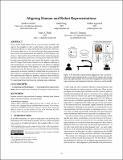| dc.contributor.author | Bobu, Andreea | |
| dc.contributor.author | Peng, Andi | |
| dc.contributor.author | Agrawal, Pulkit | |
| dc.contributor.author | Shah, Julie A | |
| dc.contributor.author | Dragan, Anca D. | |
| dc.date.accessioned | 2024-04-03T18:51:02Z | |
| dc.date.available | 2024-04-03T18:51:02Z | |
| dc.date.issued | 2024-03-11 | |
| dc.identifier.isbn | 979-8-4007-0322-5 | |
| dc.identifier.uri | https://hdl.handle.net/1721.1/154054 | |
| dc.description | HRI ’24, March 11–14, 2024, Boulder, CO, USA | en_US |
| dc.description.abstract | To act in the world, robots rely on a representation of salient task aspects: for example, to carry a coffee mug, a robot may consider movement efficiency or mug orientation in its behavior. However, if we want robots to act for and with people, their representations must not be just functional but also reflective of what humans care about, i.e. they must be aligned. We observe that current learning approaches suffer from representation misalignment, where the robot's learned representation does not capture the human's representation. We suggest that because humans are the ultimate evaluator of robot performance, we must explicitly focus our efforts on aligning learned representations with humans, in addition to learning the downstream task. We advocate that current representation learning approaches in robotics should be studied from the perspective of how well they accomplish the objective of representation alignment. We mathematically define the problem, identify its key desiderata, and situate current methods within this formalism. We conclude by suggesting future directions for exploring open challenges. | en_US |
| dc.publisher | ACM | en_US |
| dc.relation.isversionof | 10.1145/3610977.3634987 | en_US |
| dc.rights | Creative Commons Attribution | en_US |
| dc.rights.uri | https://creativecommons.org/licenses/by/4.0/ | en_US |
| dc.source | ACM | en_US |
| dc.title | Aligning Human and Robot Representations | en_US |
| dc.type | Article | en_US |
| dc.identifier.citation | Bobu, Andreea, Peng, Andi, Agrawal, Pulkit, Shah, Julie A and Dragan, Anca D. 2024. "Aligning Human and Robot Representations." | |
| dc.contributor.department | Massachusetts Institute of Technology. Computer Science and Artificial Intelligence Laboratory | |
| dc.contributor.department | Massachusetts Institute of Technology. Department of Electrical Engineering and Computer Science | |
| dc.contributor.department | Massachusetts Institute of Technology. Department of Aeronautics and Astronautics | |
| dc.identifier.mitlicense | PUBLISHER_CC | |
| dc.eprint.version | Final published version | en_US |
| dc.type.uri | http://purl.org/eprint/type/ConferencePaper | en_US |
| eprint.status | http://purl.org/eprint/status/NonPeerReviewed | en_US |
| dc.date.updated | 2024-04-01T07:46:34Z | |
| dc.language.rfc3066 | en | |
| dc.rights.holder | The author(s) | |
| dspace.date.submission | 2024-04-01T07:46:34Z | |
| mit.license | PUBLISHER_CC | |
| mit.metadata.status | Authority Work and Publication Information Needed | en_US |
